人教版新目标初中英语七年级上册What’s this in English说课稿
-
- 页数:8页
- 字数:约 7746 字
- 大小:73.50KB
- 格式:.doc
- 版本:Office2016及以上版本
- 作者:Betty设计
What’s this in English说课稿
一、说教材
Go for it! 学生用书的每个单元有6页,其中包括Section A、Section B和Self Check。Section A为目标句型提供分步示例和指导性练习;Section B使学生能够对已经学过的目标句型运用自如;Self Check使学生对自己现阶段的英语水平,即对本单元的语音目标的掌握程度有较为明确的认识。
Starter Unit 2是Go for it! 预备篇三个单元中的第二单元。预备篇是为了使没有英语学习基础的学生更好地使用本套教材而编写的。它的主要内容为26个英文字母和最基本的英语日常用语。

本单元的教学内容为:
★学习letters(Ii——Rr)10个字母;
★学习words(ruler、map、quilt、jacket、key、pen 、orange)7个单词;
★学习如何identify things 确认物体What’s this in English? 及其回答。
二、教学设计思路
Go for it! 是以《英语课程标准》为依据,以培养学生的英语语言综合运用能力为目标。每个单元的教学内容都围绕一个相对集中的主题,让学生在完成各项任务的过程中学会语言,真正体现“Learn by doing. Learn through doing.”的教学原则。但是在Go for it! 的教材上,每个单元只有一个总体的教学内容安排,既没有具体的课时数安排,也没有分课时的教学内容安排。所以,对教师来说,这是个机会——是灵活运用教材的机会。对Go for it!,任何教学内容的调整或取舍,都是合理的。但这也是挑战——教师必须从所教学生的实际水平和语言能力出发,合理安排每单元的课时数,设计好每课时的教学内容。
所以我想,教师在教学设计时,首先因根据自己学生的实际水平和语言能力,排出整个单元的总课时数,然后安排好每个课时的教学内容,设计好相应的教学步骤,以及运用相应的教学策略。
Starter 教学重点:letters(Ii——Rr)的字母教学;
What’s this in English? It’s a/an…句型
教学难点:a/an 的正确使用
整个单元的内容,我把它分配在三个课时中完成。
第一课时:完成Section A——1a,1b,1c。
课时目标:★学习key等词汇
★学习确认物体(Identify things)
★学习a/an 的初步用法
第二课时:完成Section A——2a,2b,2c,2d,3;Section B——1a,1b,2a,2b
课时目标:★学习字母 Ii——Rr
★学习拼写单词
★了解一些英语缩略词的意思。
第三课时:完成Section A——4a,4b,4c,5;
Section B——3a,3b,4;Self Check 1,2,3,4。
课时目标:★学习将相同元音音素的字母和单词归类
★巩固本单元的字母、单词和句型
★培养自我检测的能力以及学习卡片的建立。
三、教学目标
A、 语言知识目标
1、 词汇:Letters Ii——Rr
map,ruler,pen,orange,key,jacket,quilt
2、 句型:What is this inEnglish?
It is a/an map/orange…
Spell it, please.P- E- N, pen.
B、 语言技能目标
通过游戏等活动,培养学生灵活运用语言知识和勇于创新的能力。
C、 情感目标
1、 激发学生学习英语的兴趣,发挥学生学习英语的主动性;
2、 通过小组活动、组间竞赛,培养学生的合作意识和团队精神;
3、 在活动中培养学生的想象力和创造力。
四、教学策略
1、 兴趣活动教学策略:多采用做游戏和猜谜等形式。
2、 开放性教学策略:新课标的理念之一是“开发课程资源,拓展学用渠道”。这要求我们学会开放性地处理教材。在教学过程中,我们要适当借鉴其他教材的内容,插入大量学生感兴趣的图片和活动,拓宽学生的视野,实现知识的整合。
3、 任务型教学策略:任务型教学途径是以应用为动力,以应用为目的,以应用为核心的教学途径。所以教师在教学中应突出语言的应用性原则,把听说、讨论、表演、游戏贯穿于教学,使课堂形式多样化,充分发挥学生的主动性。
五、学习策略
1、 通过闪现等活动,锻炼学生反应能力和注意力集中程度。
2、 通过猜物体等活动,培养学生的逻辑推理能力。
3、 通过组内合作和组间比赛等活动,提高学生的合作能力和竞争能力,促使学生学会体验实践、参与合作与交流的学习方式。这种学法将更有利于发展学生的综合语言运用能力,使语言学习的过程成为学生形成积极的情感态度、主动思维和大胆实践的过程。
六、教学过程
The first period
Step 1Warming up
Good morning/afternoon/evening!
How are you?I’m fine, thanks.How are you? I’mOK.(S-T,S-S)
这一步,旨在引导学生在真实的交际中运用Starter Unit1中学到的日常用语,让学生体会学英语的乐趣和成功的快乐。
Step 2A Guessing game
Teachers show a part of a letter andask,“What’s this?”Get thestudents to answer the questions like this“Ithink it’s A/B.”Then show the wholeIt’s…”of the letter to let the students checkwhether they’re right or wrong
让学生从不完整的画面中通过想象力,猜出其中是什么字母。既复习学过的字母,又丰富学生的想象力。“What’s this? 是本单元的重点句型。通过这个游戏,让学生在听说中首先建立一定的感性认识,体现听说领先的原则。
Step 3Presentation
Show the picture of a girl and herroom, then present the new words and the sentences:What’s this inEnglish? It’s…
从猜谜游戏到新知识呈现,学生在悬而未决的心理状态下学习新知识,因注意力相对集中和兴趣被有效激活,对所学的东西印象深刻。
Step 4Listen, look and say
a. Section A—1a
b. Section A—1b
Step 5Word challenge
Show the things as quickly as possible,havea competition between boys and girls. Get them to name the things they see.
活动有效训练学生的有意注意力和瞬间记忆力,同时在真实的语境中使所学的语言知识得到强化。
Step 6Pair work
Get the Ss to practice the conversationin the picture. Then make their own conversations.
Step 7Group work
Students work in groups, draw a pictureOf their roomand talk about the picture.Using “What’s this in English? It’s a/an…”Teacher isready to offer his/her help tothose students who are in need of it.
学生尝试着用英语进行交际,使语言在完成任务的过程中得到运用并巩固。教师应该鼓励学生提问、获得帮助。这是培养学生主动汲取知识的好时机。
Step 8Report
Ask some demonstration groups to showtheir picturesbefore the whole class. Theymay do like this: This is my room. What’s this in English? It’sa/an…
学生分享合作的成果,感受成功的快感。在展示自我的过程中,学生体验到勇敢、积极、大胆所带来的愉快的心情体验,
Homework
1、Read and recite the new words andThe conversation in this period.
学生的基础和能力存在差异,应该允许学生将课内未完成的内容在课后完成。
2、Get the students to finish the picturesoftheir rooms and write down the English names of the things intheir rooms.
面向全体学生,让所有学生学有所得是教学的唯一目标。
The Second Period
Step 1Warming up
a. Greetings.
b. A Guessing game.
Teacher prepare8 pieces of paper with the wordsin Section A on them.Put them in a box. Get one of thestudents to pick a word out of the box. The other students ask: What’s this in English? The student answers: It’s a/an …
c、Letters challenge(Unit 1).
通过游戏来检查学生对已学知识的掌握情况,在轻松愉快的课堂氛围里,学生的积极性容易被调动,思维容易被激活。如果学生层次较好,教师事先准备的纸上可以只画物品的图案,不写英文名称。
Step 2Presentation
Teacher presents the new letters.
Step 3Listen, number and write
Section A—2a, 2b, 2c, 2d.
Step 4Letter BINGO
Get Ss to draw a form of 16 squares intheir exercise books and play theBINGO game. Teacher may get one of the studentsto call out theletters.
游戏要求学生必须全神贯注地听,并快速认读字母,训练了学生的听力以及敏捷的判断力和反应能力。教师还可以通过此游戏来检查学生的字母发音。
Step 5Look and learn
a. Section A-3b. Teacher shows morespecial letters.
c. Ss try to think of other specialletters.
Step 6Guessing game: What’s the word?
a. Teacher thinks of a word that the Ss
know. Draw a dash on the Bb for eachletter. Get theSs to suggest in turn a letter. If that letter is in the word, theteacher writesit on the appropriate dash. The first student or team to guess theword and shoutit out is the winner.b. Show the picture which matches the
补充生活中常见的缩略词,引起学生的兴趣和注意,激发他们去观察生活,使知识的学习为生活服务。猜词游戏丰富了学生的想象力,有效激活学生的探究欲望,符合学生的心理特点,很容易地把学生卷入到字母、单词的记忆和运用中,充分体现“学以致用”的原则。同时在活动中自然呈现新知识,不知不觉把学生导入到新知识的学习和运用中,从而真正贯彻了“做中学”原则。
word and ask: What’s this in English?
Ss answer:“It’s a/ an…”
Teacher: Spell it, please.
Ss spell the word.
c. Get individuals to give their ownwords.
Step 7Listen and practice
a. Section B—1a, 1b, 2a
b. Pair work: Section B—2b
Homework
a. Color and write the letters.
b. Find more special letters like NBAand theirmeanings.
开放型的作业代替机械、枯燥的抄写,培养学生的动手能力,同时使他们有机会展示自己的个性。
The third period
Step 1Warming up
a. Greetings.
b. A gameLetters line up
c. Self check—3
d. Get the students to call out theletters.
在游戏中教师检查学生对已学知识的掌握情况。游戏带来的愉快的感受能让学生积极投入到接下去的学习中。
Step 2Listen, draw and write
a. Section A—5
b .Section B—3a, 3b
通过游戏、听说、画线、排序等多种形式,学生从听说读写等方面运用学过的18个字母。
Step 3Listen and repeat
a. Section B—4 Find out how to pronouncethe letters AEIO in the words.
b. 在这一步中,学生对英语的语音知识有一个初步的认识。
b. Self check—4
Step 4A guessing game
a. Teacher shows a part of a thing, get the students to guess out the name, using: What’s this in English? I think it’s a/an… Spell it, please.
b. Section A—4a, 4b, 4c circle
c. Self check—1, 2
在游戏中,学生运用语言知识解决实际问题,活跃了课堂气氛,渐趋疲劳的注意力得到松弛。在Self check中,可以让学生既tick已经掌握的单词,并且尚未掌握的单词,然后与同伴交流,达到合作、互助的目的。
Step 5A GameFind the friend
a. Find the other student who has thesentence that can match his own.
b. Report in pairs.
c. Make conversations with the sentences.
此游戏旨在复习Starter Unit1—2中出现的日常用语。在学生积极、主动寻求答案的过程中将整节课推向高潮。
Homework
1. Vocab-builder
Get thestudents to line up the words they knowin U2.
2. Get the students to make up theirown wordguessing games. Get readyto share with the class in the next period.
让学生会自我小结与评估,形成性评价丰富了终结性评价的不足,增强学生学习的信心。发散性的课外作业,培养学生创造性思维。同时,让语言知识的学习与巩固以积极的方式从课内延伸到课外。
您可能喜欢的文档
查看更多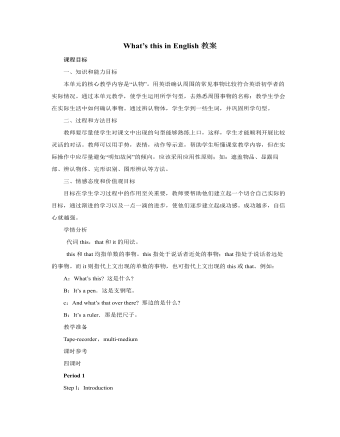
人教版新目标初中英语七年级上册What’s this in English教案
- 页数:6页
- |大小:58.00KB
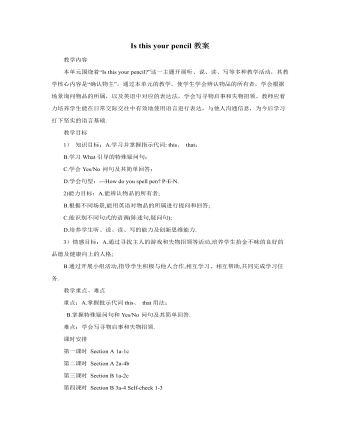
人教版新目标初中英语七年级上册Is this your pencil教案
- 页数:18页
- |大小:94.00KB
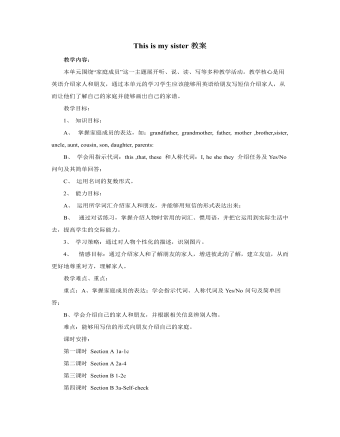
人教版新目标初中英语七年级上册This is my sister教案
- 页数:12页
- |大小:79.00KB
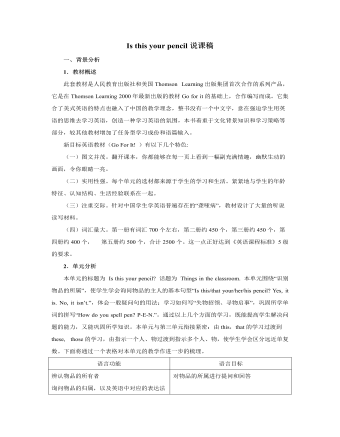
人教版新目标初中英语七年级上册Is this your pencil说课稿
- 页数:14页
- |大小:94.00KB
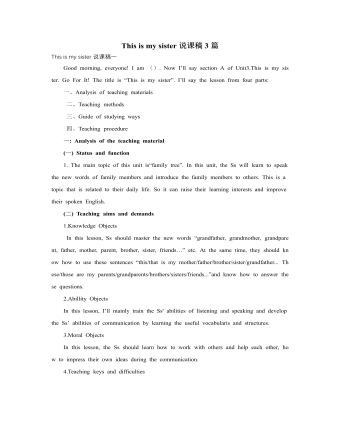
人教版新目标初中英语七年级上册This is my sister说课稿3篇
- 页数:10页
- |大小:68.00KB
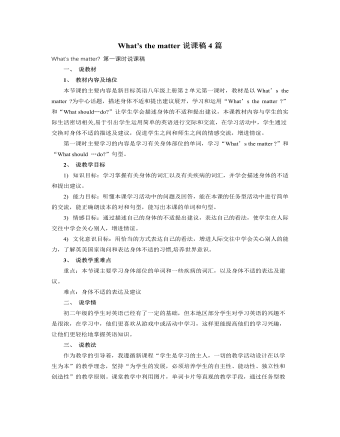
人教版新目标初中英语八年级上册What’s the matter说课稿4篇
- 页数:17页
- |大小:91.00KB
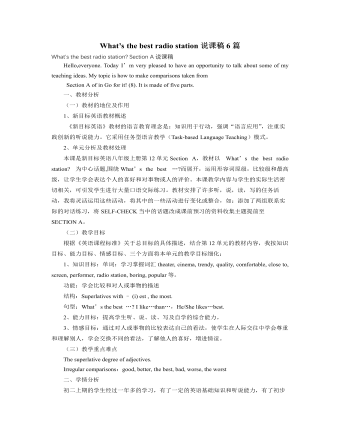
人教版新目标初中英语八年级上册What’s the best radio station说课稿6篇
- 页数:24页
- |大小:203.50KB
热门说课稿
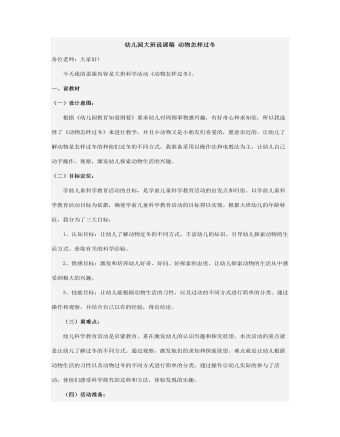
幼儿园大班说课稿 动物怎样过冬
- 页数:3页
- |大小:36.00KB
- 说课稿
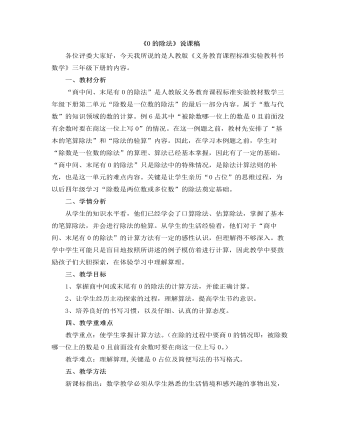
小学数学人教版三年级下册《0的除法》说课稿
- 页数:6页
- |大小:34.92KB
- 说课稿
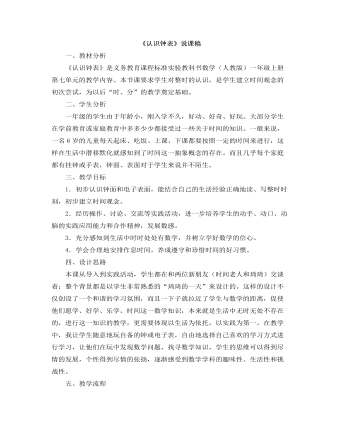
小学数学人教版一年级上册《认识钟表》说课稿
- 页数:4页
- |大小:24.27KB
- 说课稿
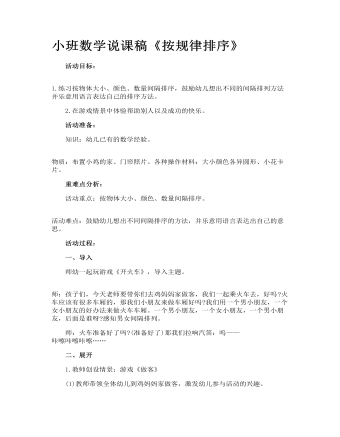
小班数学说课稿《按规律排序》
- 页数:5页
- |大小:92.24KB
- 说课稿
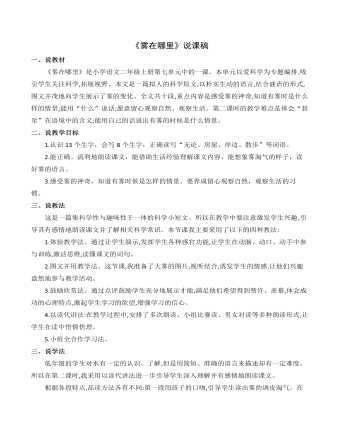
雾在哪里说课稿
- 页数:3页
- |大小:46.00KB
- 说课稿
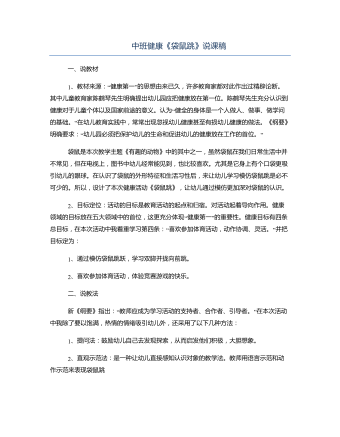
中班健康《袋鼠跳》说课稿
- 页数:2页
- |大小:34.88KB
- 说课稿
今日更新
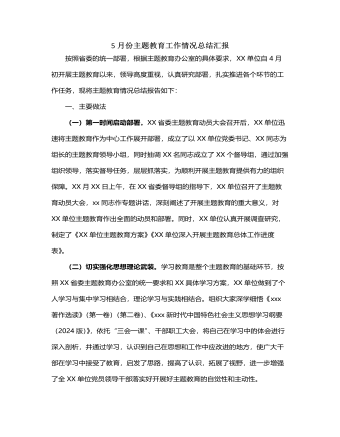
5月份主题教育工作情况总结汇报
- 页数:3页
- |大小:136.87KB

××县招商局2024年上半年工作总结
- 页数:12页
- |大小:142.54KB
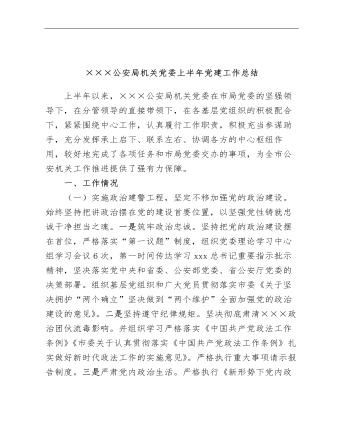
×××公安局机关党委上半年党建工作总结
- 页数:7页
- |大小:186.25KB

《2019—2024年全国党政领导班子建设规划纲要》实施情况的工作总结3800字
- 页数:6页
- |大小:29.16KB
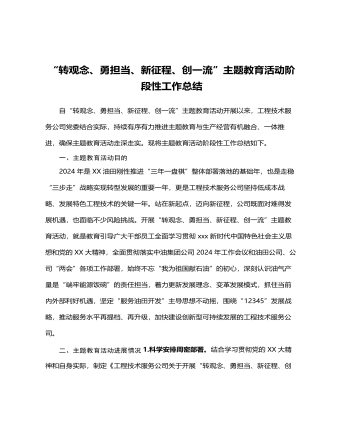
“转观念、勇担当、新征程、创一流”主题教育活动阶段性工作总结
- 页数:3页
- |大小:22.76KB

“四零”承诺服务创建工作总结
- 页数:5页
- |大小:39.83KB





